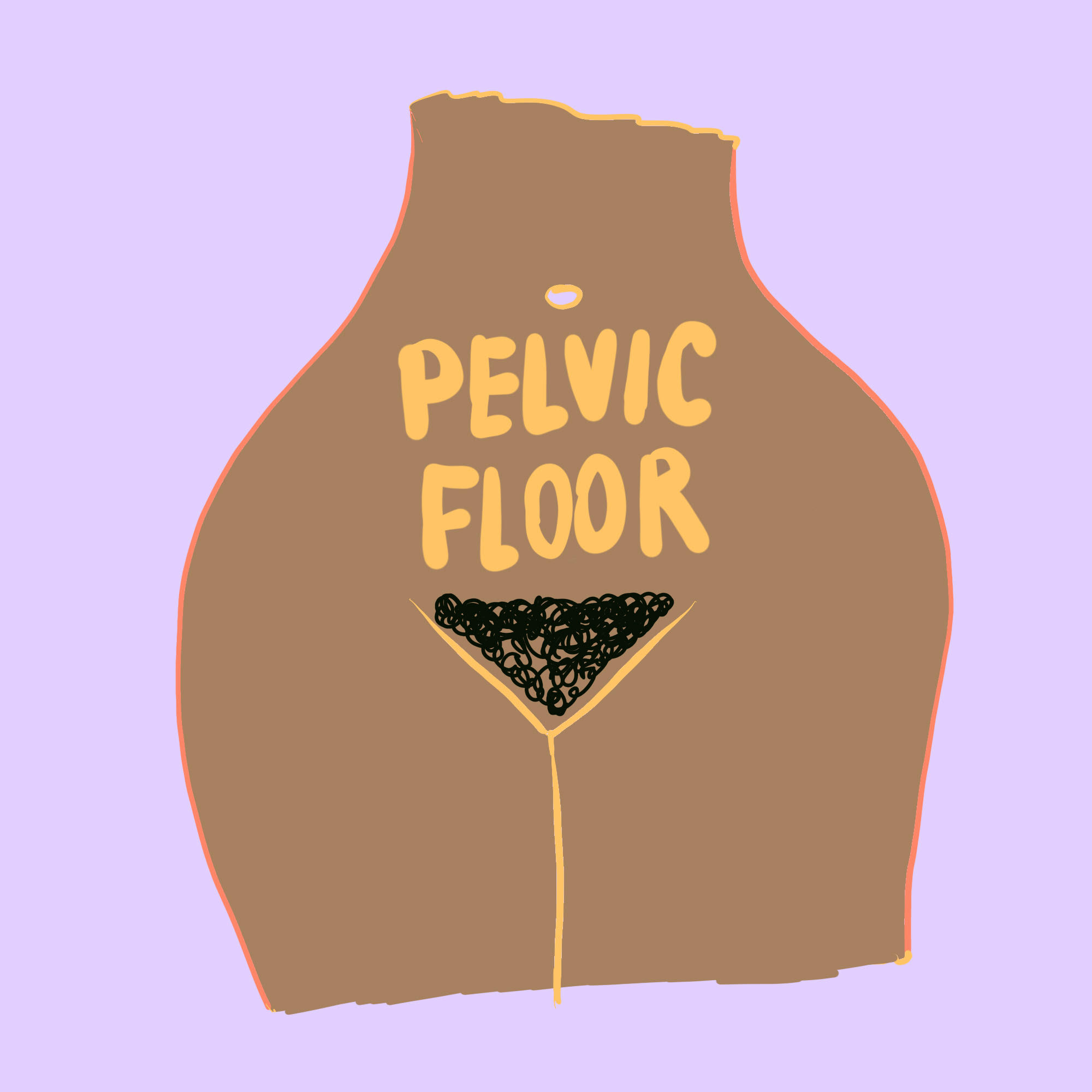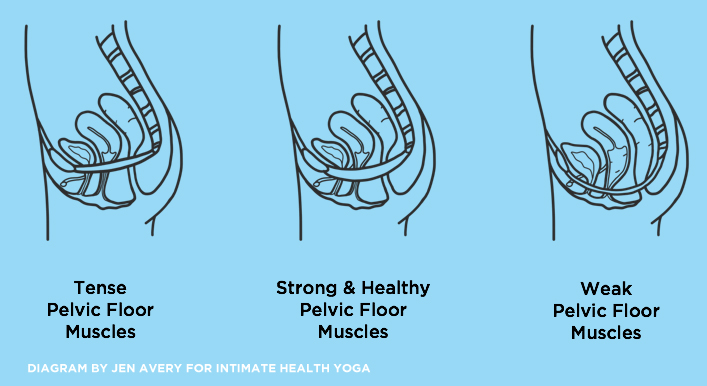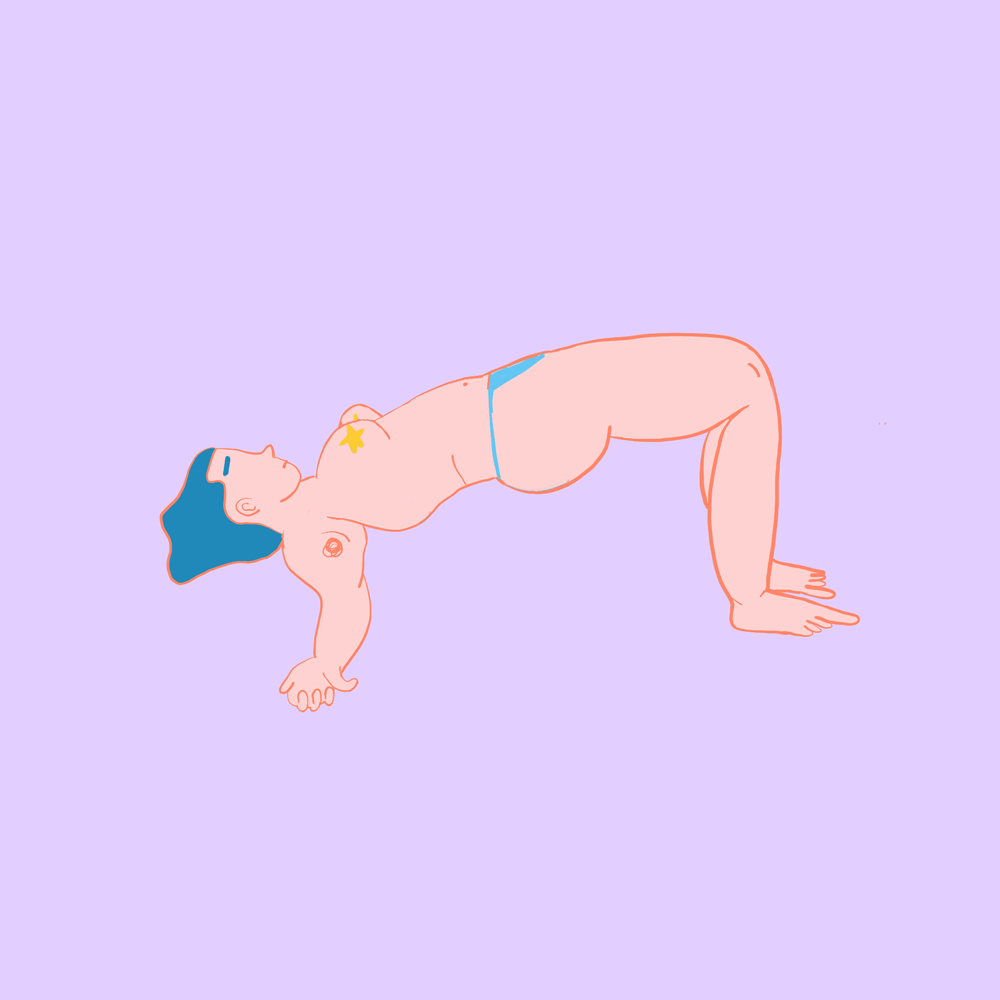Pelvic Floor
AUTHOR: Courtney Avery
ILLUSTRATIONS BY EVA HILL
The Sex Ed believes it is important to appreciate the anatomical and bodily systems that are crucial to our overall wellness and reproductive health. The more we understand about how our bodies work, the more we’re able to enhance and explore our sexual experiences!
Power of the Pelvic Floor
The pelvic floor is a group of muscles and connective tissue that span the area of the pelvis to support your internal reproductive organs and to control the anal sphincter, urethra, vaginal opening and blood flow to the penis. Your pelvic floor regulates major bodily functions including urination, defecation and you guessed it-- sexual function!
How do I find my pelvic floor?
Stop and take a deep breath in, and out. With your next inhale, squeeze the muscles you would use to stop your pee, and hold them in. As you exhale, release those muscles. The muscles you just engaged in this practice make up your pelvic floor.
How it Works
Pelvic floor muscles have the special capabilities to tighten, lift, squeeze, and relax. They can do so in three different planes. These muscles are special because they can be consciously controlled and trained. For example, you can lift the muscles up and in toward the torso, squeeze the muscles around the urethra to stop your flow during urination, or your anus to prevent the passing of gas. For those with vaginas, the pelvic floor muscles are like the shape of a figure 8, wrapping around the opening to the vagina and the anus. The many muscles of the pelvic floor are interconnected, and thus work together to control different functions.
Pelvic Floor Awareness
If we are not in the practice of bringing awareness to the pelvic area, we create a disconnection. This disconnection grows over time because your mind is not accustomed to thinking about this voluntary muscle. Your pelvic floor is the base of your body. When you move from a place of awareness, you have better postural alignment which promotes greater awareness of your entire body.
While having sex, contracting and relaxing the pelvic floor can feel amazing for everyone. People with penises can pulse their penises by engaging and releasing these muscles. People with vaginas can squeeze around a penis, finger, dildo, or whatever one is experimenting with.
The benefit of being aware of your pelvic floor muscles during sex play can create more connection and an incredible mindfulness practice. Next time you have sex, pay attention to what happens in this muscle group without controlling anything at first. You may notice that you tense up a lot, or that you relax a lot. No judgement! The fun happens when you become more aware and play with contracting and relaxing at different points.
Try this at home: One of my favorite practices is to consciously contract my pelvic muscles during intercourse and when I feel my climax approaching, I relax and let go into a wild orgasm.
When you become more aware of these muscles and play with different variations in how you use them, your sex can become AMAZING. There is no wrong or right way to do this kind of sexploration, so have fun with it!
Healthy Pelvic Floor Muscles
Think of your pelvic floor like a hammock. When it is pulled too tight, you can’t stay on it, instead, you bounce off like a trampoline. When the hammock is tied too loose, you end up with your butt on the ground. When the hammock is tied just right between two trees, it cradles you with a perfect curve so that you can lie comfortably with enough space to move around or invite someone in for a good hammock cuddle.
Healthy muscle tissue is both strong and flexible. A healthy muscle is strong enough to help your body function as it should. A healthy muscle must also be able to relax and stretch to avoid injury and chronic tension. A healthy mind-body connection ensures that we are aware when a muscle is too tense, or too weak.
“You want the pelvic floor to be toned, not tense,” explains physical therapist and pelvic floor specialist, Karen Vande Vegte. Some of her pelvic pain clients are very strong people that are constantly contracting their abs and glutes, putting strain on their pelvic floor muscles. So, as much as it’s a positive thing to strengthen your core and keep it engaged during a workout, you need to make sure to follow that tension and training with a release.
I’m telling you, it is OK to stick your belly out and let it all hang loose. Keeping your muscles soft and pliable like this feels good, and is necessary to maintain a good healthy balance in your muscle tissues.
Kegel Care
The pubococcygeus muscle (“PC muscle”) stretches from the pubic bone to the tailbone regardless of whether you have a penis, vagina or are intersex. This muscle is responsible for controlling urine flow, contracting orgasms, ejaculating semen from penises, and pushing babies out.
In 1948, Dr. Arnold Kegel published an article explaining a non-surgical way to control incontinence (peeing when you don’t want to) after childbirth. At the time, it was a novel idea in the American medical community that working these muscles alone could make a difference, when they had developed a successful surgical fix for the issue.
A “kegel” is the act of engaging the PC muscle and holding it for a few seconds, followed by a long release. (You tried this at the beginning of this essay.) I distinctly remember reading a teen magazine as a young girl that recommended doing 10 kegels at a stop light as a daily reminder. What I did not know then, was that the proper way to strengthen the PC muscle is to engage and hold the contraction for a few seconds before relaxing it completely. That would be a pretty long stop light.
Orgasm and the Pelvic Floor
In one research study, 176 women were clinically evaluated to determine their pelvic floor muscle strength and given a questionnaire called the Sexual Function Index to examine the correlation between pelvic floor muscle strength and sexual functioning. They found that women with moderate to strong pelvic floor muscles had higher scores when it came to orgasms and arousal, than women with weaker pelvic floor muscles.
For those with vaginas, the PC muscles directly affect the amount of sensation experienced in the genitals by controlling the grip around whatever is penetrating the vagina. During the climax of a vaginal orgasm, the body’s physical response is to contract the pelvic floor muscles rhythmically. For those with penises, the pelvic floor muscles contract to keep blood supply in the penis to maintain an erection. During their climax, these muscles control the release of semen. In the resolution phase after climax, the pelvic floor muscles release completely after the workout they just had.
In this way, you can see how important it is to have strong muscles that can also release sufficiently to bask in the afterglow of sex.
Myth Busting
First, a “tight pussy” does not mean anything! Vaginas can expand and contract more than you think. Some vaginas are wider, some are smaller. It doesn’t necessarily mean you have a strong or weak pelvic floor. A baby moving through the birth canal is not going to “ruin” your vagina forever. Will your vagina change? Perhaps, and that’s ok! There are many therapeutic exercises and techniques to recover from childbirth to make this area feel better than ever.
Second, I would like to abolish the idea that “stronger is better.” There is a lot of buzz right now about vaginal weightlifting, kegel exercises, etc. While it is positive that pelvic floor health is gaining attention across mainstream and wellness media, I cannot stress enough that when you engage in pelvic strengthening exercises, you must also adequately relax these muscles after engaging them. Strong is good, but tense is not. It’s a balance.
Although symptoms of weak pelvic floor muscles tend to be more clear and straightforward, symptoms of “nonrelaxing pelvic floor dysfunction” vary drastically from person to person. They are often attributed to other health concerns, making it tricky to diagnose and treat.
Symptoms of Pelvic Floor Problems
The pelvic floor is a complicated network of tissues that is different in every body, so not all issues are the same and some require specific treatment.
Disclaimer: While I am not a physician and there is more medical background about this subject, here are some common symptoms that can indicate pelvic floor problems:
Peeing when you don’t want to: sneezing, coughing, etc.
Constant need to go to the bathroom, and/or not making it in time
Accidentally passing gas
Prolapse
For those with vaginas: It may feel like a bulge in the vagina or heaviness, pulling, dropping, and pretty uncomfortable
For those with penises: It may feel like a bulge in the rectum, like you need to poop but you can’t
Tense Pelvic Floor Muscle Symptoms
Difficulty fully emptying your bladder or defecating
General pain in the pelvic region
Painful sex
Small bowel movements
Too Weak? Strengthen Your Pelvic Floor
If you know that it is time to strengthen your pelvic floor, I encourage you to talk with a health practitioner, like a pelvic floor physical therapist, to come up with a plan that fits your needs. There is no one-size-fits-all method to strengthen the pelvic floor or fix every issue. Each person is unique, and I encourage you to get creative and explore what feels right for you (I’ve included a few exercises below).
The type of pelvic floor engagement and number of repetitions per day may vary, so start small and see how you feel. Adding repetitions of proper pelvic floor muscle engagement to your daily routine may help to improve many issues associated with a weak pelvic floor. It takes time, so be patient! Researchers found that people see a notable difference between 4 weeks and 6 months depending on the condition.
According to research, fitness practices that develop core strength such as Pilates and yoga help to build pelvic floor strength. Be sure that you choose a fitness class that meets your needs! The classes I teach that build pelvic floor strength, are always followed by lots of releasing and relaxing.
Seeing a Pelvic Floor Physical Therapist/What To Expect
Seeing a pelvic floor physical therapist can be eye-opening and extremely helpful, whether or not you have a major issue. They will asses exactly which muscles need to be strengthened and/or relaxed, where scar tissue lies, and much more.
A physical therapist specialized in pelvic health will most likely perform an internal assessment by feeling the muscles inside your vagina or anus with a gloved finger.
It is important to feel comfortable with your physical therapist so you can relax and breathe through the assessment. If this sounds nerve-wracking, have a conversation with your physical therapist beforehand and ask them questions about what to expect. You'll leave your appointment with specific exercises and techniques that you'll practice to improve your pelvic health.
Ask your healthcare practitioner for a referral or recommendation for a physical therapist that can address your specific concerns.
How to Ease the Tension
If you know your pelvic floor muscles could use a break, it is very important to work on releasing tension here so it does not become chronic and manifest into a bigger issue down the road.
One thing to look for: Is your jaw tight? Like every part of your body, your jaw and your pelvis are interconnected. When people have jaw tension, they may also have pelvic floor tension. I see this in my yoga classes in hip-openers-- my students with tighter hips will tense up their jaws. When they are cued to relax their jaw, they surrender to the sensation of the hip-opener and soften, falling deeper into the pose. I feel this in my own practice, and it is like taking a sigh of relief when I surrender my jaw and pelvic tension in a triggering pose.
There are a number of reasons people experience tension, or nonrelaxing pelvic floor dysfunction. These include stress and anxiety, physical and emotional trauma, overworking the muscles without releasing them, and more. Seeing a pelvic floor physical therapist is one way to help you identify which muscles need to be released and how.
Relaxing yoga, meditation, acupuncture, and other forms of stress relief can drastically improve general tension in the body. Just like other types of muscle tension, massage works too! See below for tips for a relaxing pelvic floor massage.
Pelvic Floor Tension Releasers
Uncross Your Legs.
You may have been taught to be “polite” and keep your legs crossed, but if you already have pelvic floor tension, this could add to the mix. From an alignment standpoint, it leads to poor spinal posture, uneven hips, and tension in the inner hip and pelvic floor muscles. Uncross them! Let it all hang out! Sit confidently with your legs hip distance-width apart or wider! If you do need to cross your legs, make a figure 4 shape with your ankle on top of your opposite thigh, and press your bent knee down to help open the hips. That is a great way to get in hip-openers while sitting.
Take Deep Belly Breaths.
Your abdominal muscles are connected to the pelvic floor muscles. When one contracts, so do a chain of others. Stress and heavy emotional situations can cause this tension. When you feel your pelvic floor or abs clenching outside of an exercise, take a deep breath and pull the breath down to the belly by filling it up and sticking your gut out with the inhale, feeling it pull down into the pelvic floor. Let everything relax with the exhale.
Intimate Pelvic Floor Release Massage - 1:1 or with company
This is something you can do on yourself or with a partner.
1. Wash your hands and use a lubricant of choice.
2. KEEP IN MIND: This area is very sensitive, so start with very light, gentle pressure, and for a short time on each area, less than 1 minute is fine. These sensitive muscles can become sore much faster than other areas of your body, so be aware and stop if it becomes too much.
3. Begin by massaging your belly. Massage your belly in a circular, clockwise motion to encourage healthy digestion.
5. Work your way down to your gluteus area. Find your sits bones and massage the muscle on the inside surrounding the anus. If there are any tense spots, you may or may not notice them relax under your hands as you knead your fingers gently into the muscle.
6. For Vaginas:
Work your way slowly into the opening of the vagina when you feel comfortable, using one hand, thumb inside and fingers outside.
Hold the muscle just on the inside of the vaginal wall between your finger and thumb and gently press them together to feel the muscle tissue release. If this is too much, you do not have to apply this type of pressure. Only if it feels good!
With your thumb still inserted, move it in an outward direction, like you are dilating this tissue and encouraging the vagina to open, release, and relax.
Switch your hands to get the other side, and downward towards the anus.
7. For Penises:
Continue to massage and knead the area underneath the penis, around the anus, and on the inside of the sits bones. Alternate between using your fingers and kneading with your knuckles.
When you feel tension or resistance in the muscle tissue, try to relax with deep exhales and see if you can feel the muscle relax under your fingers.
If there is tension around the anus, gently knead the muscles around the area towards the sits bones. You may or may not feel the muscles release, so be sure to stop if you feel any pain or soreness.
8. To end the massage, apply your palms flat over the areas you massaged to feel safe and grounded.
9. Be aware of how your muscles feel over the next day or two. You will know if you need more or less of what you’ve tried.
Try These Pelvic Floor Exercises:
PC MUSCLE BUILDING
Try this seated at first.
On the inhale, squeeze your PC muscles like you were stopping your pee AND a fart at the same time, you should feel the pelvic area pulling up and into the torso. Keep your glutes and thighs relaxed to isolate the pelvic floor muscles.
Hold this up to 8 seconds or less while you hold the breath in to isolate the abdominal muscles.
With the exhale, relax the muscles and make sure you fully release.
If you’re new to this, start with just a few every morning. Work your way up to 13 maximum- this can be a great way to meditate. At the end of the reps, be sure to sit and relax completely for a few minutes.
INTIMATE PC MUSCLE BUILDING FOR VAGINAS
Lie on your back with your knees bent and feet on the bed/ground below the knees OR find a comfortable seat. Your position will depend on your arm-to-torso ratio. If you have shorter arms, lying on your back with a pillow under your hips may help you reach.
Insert your clean index or middle finger into your vagina. If it feels better for you, use a lubricant.
Repeat steps 2 to 5 in the exercise above. You will be able to feel your muscles contract and relax with your finger. This feedback can be very useful to see how much you are engaging and releasing.
SEXY BRIDGE LIFTS FOR ALL
Lie on a flat ground or yoga mat with your knees bent, heels directly below the knees on the ground, arms straight by your side, palms facing down.
As you inhale, lift your hips off the floor, using your quads, glutes, and core while you engage your PC muscles.
Hold for 3 seconds.
As you exhale, release your hips back to the ground and relax.
Start with 10 of these in a row, rest for 60 seconds, and repeat another round. Start small and work your way up to 6 reps each day.



